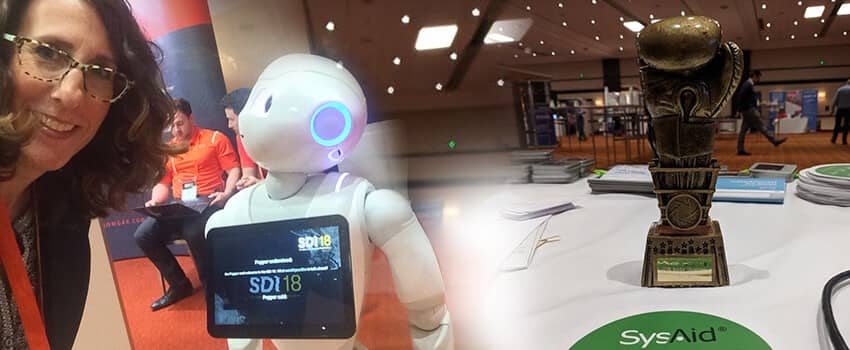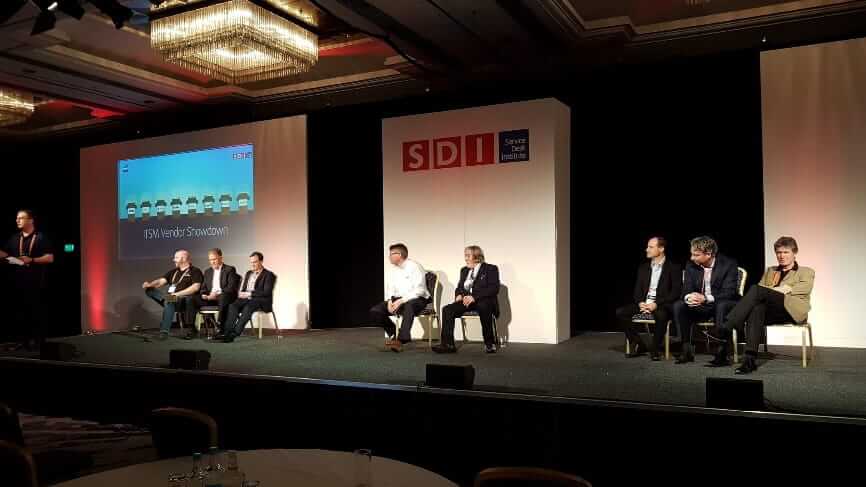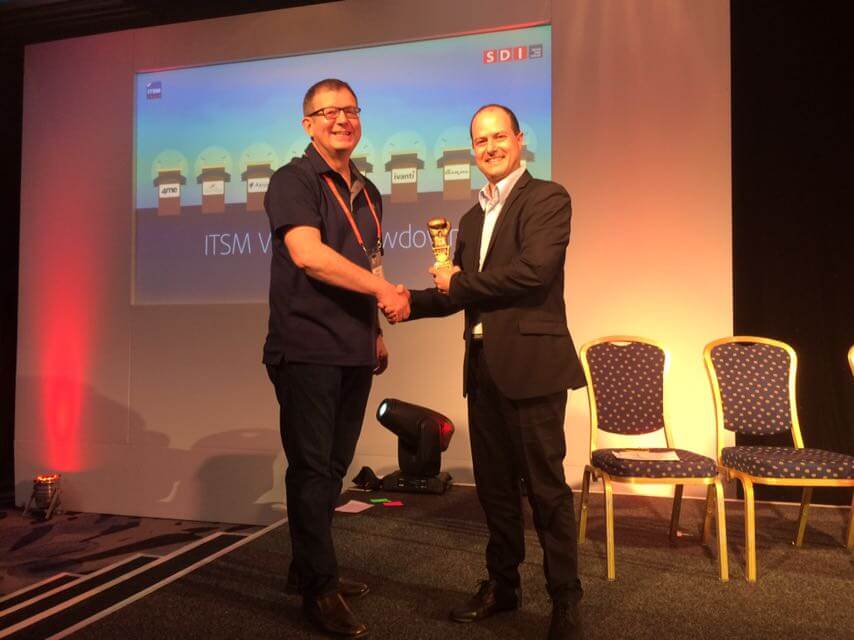Change, ITSM Tool, Robot, Metrics, and Cloud Learnings from SDI

I’ve now been back from the Service Desk Institute (SDI) 2018 conference (SDI18) for nearly two weeks and I still can’t believe what a whirlwind of IT service management (ITSM) and service desk knowledge-sharing it was. I’ll definitely go to SDI19 if allowed the time.
There was some great content available – with the usual ITSM-conference issue of needing to choose between competing sessions across multiple streams. I had to make some tough choices, and I’m now using this blog to share, with the wider (and global) ITSM community, some of the things I learned.
But, before I jump into the content nuggets, it’s also worth mentioning the conference’s “feel” – that, unlike some of the other conferences I’ve been lucky enough to attend, you get a real sense that the SDI conference is built around the attendees. That the conference is all about the SDI members and their needs. It’s a great experience if you ever get the opportunity to attend.
So, What Did I Learn?
Well, the first thing is that: “time and tide waits for no man (or woman).” I had planned to see so much more at SDI18, but the pace of session delivery was rapid. Plus, of course, then “work happens.”

I did find some great nuggets though in many of the sessions, including:
- Vawns Murphy – “How to Manage Change Like a Rockstar!”
- The ITSM.tools-hosted ITSM Vendor Showdown panel – a fun, yet informative, knockout competition fueled by crowdsourced questions
- Carl Clement and Pepper the Robot – “An Introduction to Social Robotics”
- Stuart Rance – “Metrics and Measurement”
- Stevie Chambers – “A Practical Guide to Cloud for Grownups”
Here’s some of my key learnings from each…
How to Manage Change Like a Rockstar!
I didn’t actually get to Vawns’ sessions due to work commitments, but I did follow it closely on Twitter – saving her ITSM nuggets, via attendee tweets, along the way.
So, what did Vawns share with her audience? There was a big emphasis on keeping things simple – as complexity leads to people trying to make things simpler themselves, i.e. circumvention of the agreed process. For instance:
- “Don’t make it a 15-minute epic deal to raise a change. Otherwise people will simply circumvent the process. MAKE IT EASY.”
- “Golden rules for your change management policy = make it clear (no ITIL wording!!!), concise and in line with existing company practices where possible.”
- “Template everything you do so you can log a change in 10 seconds.”
You need to prepare for major incidents – if your change management policy doesn’t include this provision all hell will break loose and people will just do whatever is quickest and easiest at the time – @vawns #SDI18
— ITSM.tools (@itsm_tools) March 13, 2018
Vawns also offered a lot more advice on some of the change management aspects that should be addressed to maximize the chances of consistent change management success:
- “The change process should be a living, breathing document. A healthy process must change over time, which includes simplification and removal of barriers. If your only instinct is to add bureaucracy where do you end up?”
- “Automate your standard changes. Regularly review what makes sense to automate and what doesn’t.”
- “You don’t need perfect tools to do great ITSM.”
Vawns’ key takeaways were:
- Use your (change management) policy to set scope.
- Make your (change management) process clear, concise, and easy to understand.
- Always make it easy to raise changes!
- Sweat the details.
- Play nicely at CAB (change advisory board).
- It’s good to talk.
- Keep moving forward.
If you’re just getting started with change management, you can get more wisdom from Joe the IT Guy’s blog: 15 Tips for Getting Started with Change Management.
And I’ll finish on this one by just leaving this great tweet from Simon Morris here:
Oh god. The Change Advisory Board.
The death march.
The meeting of “no”
The meeting of “let’s talk about implementation”
The meeting of “let’s spend 50 minutes discussing the first agenda item, and approve the next 9 in 5 minutes”.@vawns #SDI18 #ITSM
— Simon Morris (@Simo_Morris) March 13, 2018
The ITSM Vendor Showdown Panel
This experiment in ITSM-conference panel format, and ITSM-vendor involvement (yes, we are all very human), included some very smart participants from: 4me, Alemba, Axios, Fusion GBS, Hornbill, Ivanti, Marval, and SysAid.

- Why do so many great organizations struggle to get value from their ITSM toolset?
- What are your plans are to align to the new ITIL version?
- What is the one thing that most IT service desks don’t do that they should do?
- What are you doing in your product roadmaps to stay ahead of the game with AI/bots?
- As an ITSM vendor, keeping the technology aside, how do you help your customers to keep up with the pace of change in ITSM?
- If you had to pick only one, what is the biggest challenge facing service desks today and how do you advise they overcome it?
- What can we do to make IT self-service finally work? And do you think that new technologies will help?
The audience voted on their preferred answers and the round winner went on to pair up against the next vendor contestant, until there was only one person standing. And lo and behold – that last one standing was my SysAid colleague Oded Moshe, who eventually won in the final round against Gary Pruden of Fusion GBS.

Regarding the contestants’ answers during this vendor showdown, I know ITSM.tools is looking to create a blog from the best answers so I won’t post them here….we’ll wait for that.
Meet Pepper, Humanoid Robot & Customer Service Agent
Given the popularity of Pepper the Robot at SDI18, I now feel really bad that I didn’t bring Joe the IT Guy with me to SDI – Pepper and Joe would’ve been fast friends! You wouldn’t believe how much attention Pepper received throughout the conference.
Carl Clement – Pepper’s “handler” – presented on the popularity of robots in certain human-facing service tasks. From assisting in healthcare to offering IT support – where, for a large telecoms company, Pepper can answer over 30% of questions that people ask the service desk:
Assistive robotics.. brilliant advancement in technology. #SDI18 @PepperTheRobot &@RoboRadical – https://t.co/p5A22FGa7C pic.twitter.com/YKLUGOMOFi
— MetricNet (@MetricNet) March 13, 2018
Pepper was initially used in a supermarket, where it was concluded that people would rather speak to a robot than other people! It seems there’s less pressure and the robot is more credible. Take, for instance, wine &endash; would a Frenchman take wine advice from a person? Heck no. But a robot’s convincing! And the trial store sold more wine with Pepper on staff.
It’s clear that the future of robotics is not that far off. My tweet of one of Carl’s slides outlines what he sees for the future (I know the photo is dark but if you click on the tweet itself, you’ll see the slide image better):
Future of robotics #SDI18 pic.twitter.com/AnZ5znijtz
— Dena Wieder-Freiden (@denawf) March 13, 2018
Metrics and Measurement
From the super-modern Pepper, I moved on to the super-colorful Stuart Rance talking about service desk metrics. Stuart set the scene for his session really well by offering sage advice on how organizations should approach their metrics, starting with how to better meet customer expectations:
- “How do you satisfy customers? Firstly, set (and manage) expectations with the customer and, secondly, do what you said you would.”
- “Don’t confuse critical success factors (CSFs) and key performance indicators (KPIs).”
- “Use KEY PERFORMANCE indicators! Not EPIs (everything performance indicators).”
Common reporting pitfalls #sdi18 @StuartRance pic.twitter.com/nkqboE4OIT
— vawns (@vawns) March 13, 2018
Stuart also spoke to the importance of communication and reporting.
From keeping end users informed…
“If a customer calls up and asks you the status of an incident, you’ve already failed” @StuartRance #SDI18
— Sanjeev NC (@yenceesanjeev) March 13, 2018
…through the real value received from the time invested in reporting, to how metrics influence actions:
- “Never use reports to prove quality of service, customers already know that. Reports must identify and advise future actions.”
- “A top 5 problem report is a very powerful service desk tool.”
- “Eli Goldratt: We will behave only according to our KPIs rather than what’s good and correct.”
The last point is so, so important. We need to understand how metrics – especially the wrong metrics – drive human behavior. This was summed up really well in a tweet by Rob England, The IT Skeptic:
“Give a manager a KPI and they will meet it if they have to destroy the company in the process”
— Rob England (@theitskeptic) March 14, 2018
Stuart’s key takeaways:
- Don’t have KPIs for their own sake – every KPI should underpin a CSF
- Have as few KPIs as possible – but as many as you need
- Ensure your KPIs are balanced – across many different dimensions
- Every report should lead to actions – based on analysis of data
- Understand how metrics influence behavior
You can read more of Stuart’s service desk metrics wisdom here.
A Practical Guide to Cloud for Grownups
Stevie Chambers is a well-worn – and he would say “worn-out” – cloud professional who is happy to tell people some home-truths about cloud usage. For instance, that: “The thing about cloud is that you can’t hide – you know how much is being spent and wasted.” Thankfully though, he is happy to talk about the benefits of cloud adoption too.
Basically, the benefits of well-executed cloud services are the same four things that any business service needs:
- Reduced costs
- Increased uptime
- Proper event response
- Cloud innovation
There are many challenges though:
#SDI18 @ukcloudpro top 5 cloud challenges pic.twitter.com/0ehSDqM7hk
— Stuart Rance (@StuartRance) March 14, 2018
With these not necessarily what you might think.
- “It’s so easy to overspend with cloud because the people engaging the services often have no line of sight of costs (and don’t turn services off when they aren’t needed).”
- “Security – the original biggest cloud concern – is better in the cloud” (as per the tweet below).
- “Unless your company has a billion-dollar security budget you can’t beat the security features available from cloud service providers such as AWS (and some of these features are free).”
#SDI18 @ukcloudpro “security is better in the cloud” pic.twitter.com/5WkUrgdG6K
— Stuart Rance (@StuartRance) March 14, 2018
As SDI18 was an ITSM and service desk conference, Stevie had tailored his presentation to the fact that there’s a huge connection between ITSM and cloud but he rarely sees it working properly. And that all of ITSM and ITIL applies to cloud:
All of #ITSM and ITIL applies to #cloud @ukcloudpro #SDI18 pic.twitter.com/lvg4W4ToM5
— Dena Wieder-Freiden (@denawf) March 14, 2018
One example of Stevie’s key takeaway groupings followed a plea from Stevie for ITSM professionals to get more involved with cloud service delivery because of their skill sets (and because certain tasks and responsibilities are falling through the cracks). His action plan for the (new role) of CSDM (cloud service delivery manager) includes:
- Getting involved in your cloud programs – cloud is about delivering services NOT technology.
- Thinking of cloud as wiring together cloud services to build business services.
- Not letting cloud finance, security, or operations fall through the cracks – and, as a service owner, beware of S.E.P. (someone else’s problem) SYNDROME.
So, there you have it, my quick summary of many of the things I learned at SDI18 – I hope they will be helpful to you too.
Did you find this interesting?Share it with others:
Did you find this interesting? Share it with others:









